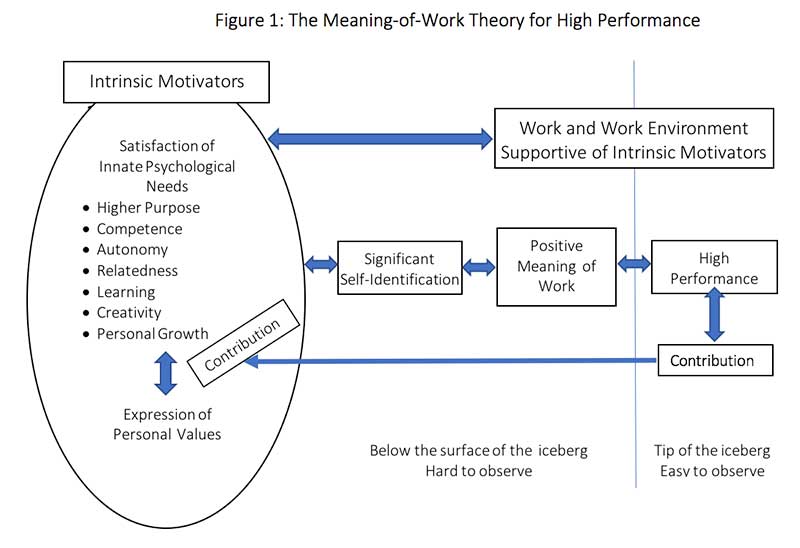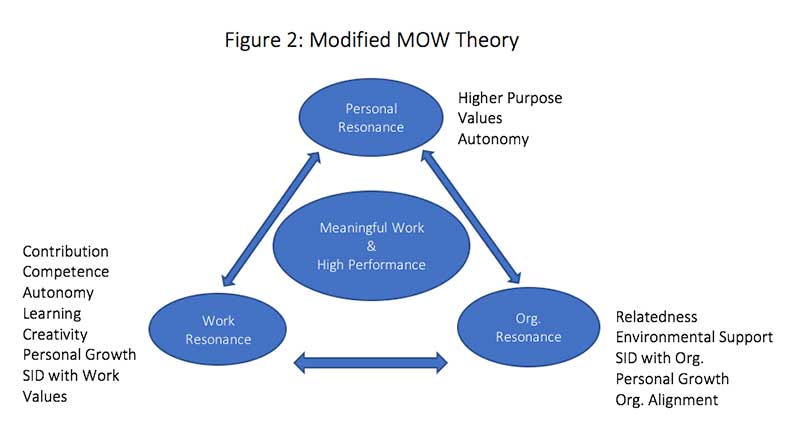Changing Environments
Over the past decade, “meaningful work” has become a phrase I see more frequently in management and leadership circles. Google Scholar searches for the term “meaningful work” yields 16 items between 1981 and 1990, 38 between 1991 and 2000, 140 between 2001 and 2010, and 297 between 2011 and 2018. I am quite delighted that many different models on meaningful work now exist in divergent disciplines—from management to psychology to philosophy to economics (e.g., Askinosie & Askinosie, 2017; Beadle & Knight, 2012; Bendassolli, Borges-Andrade, Alves, & Torres, 2015; Chalofsky, 2010; Fairlie, 2011; Hakala-Ausperk, 2017; Lips-Wiersma & Morris, 2011; Martin, 2000; Michaelson, Pratt, Grant, & Dunn, 2014; Poswolsky, 2016; Roessler, 2012; Spencer, 2015; Tummers & Knies, 2013; Veltman, 2016; Wong, Ivtzan, & Lomas, 2017; Yeoman, 2014). In this essay, I share the work I consider my life work—albeit slow-going—to reduce suffering in the workplace and promote meaningful work for sustainable growth.
Before I delve into my work on “meaningful work,” let me share exciting trends I’ve noticed in recent years. First, I started to find articles in economic blogs and journals that consider “meaningful work” in creating an economic model (Goodwin, 2017; Spencer, 2015). This is big. As a person who wants to see a change in the definition of wealth to include well-being (i.e., meaning, happiness, and physical health), I believe “meaningful work” must be part of economic modeling and development. Despite the complexity of measuring “meaningful work,” economists are finally making a move! Second, in 2016, the Academy of Management (AOM) had its annual conference theme of “Making Organizations Meaningful.” Management scholars and consultants are catching on, too, in a big way! Third, Harvard Business Review, a very popular magazine amongst business leaders, published articles on meaningful work in recent years—e.g., “Meaningful Work Beats Over-the-Top Perks Every Time” (McCord, 2016); “Meaningful Work Should Not Be a Privilege of the Elite” (Straub & Kirby, 2017); and “Every Generation Wants Meaningful Work—but Thinks Other Age Groups Are in It for the Money” (Weeks, 2017). These article titles alone indicate that a big shift toward “meaningful work” is taking place in the corporate world previously often described as greedy and cutthroat.
Combined with the popularization of mindfulness practices, conscious capitalism (Mackey and Sisodia, 2014), and stakeholder capitalism (Freeman, Harrison, Wicks, Parmar, & De Colle, 2010), even big corporations are now trying to authentically become more humane in doing their business. For example, Microsoft has been fostering compassionate culture to do good business. Yet, at this point, corporations often use the commonly-used default proxy mechanism of Gallup’s Employee Engagement Survey to link workers and their productivity. While this survey with 12 questions penetrated the market, there is a renewed debate if the survey indeed measures employee engagement and if those 12 questions are relevant across cultures. The 2015 survey results tell us that only 13 percent of workers are fully engaged worldwide, and 31 percent in the United States (Mann & Harter, 2016). If we assume that the higher the engagement rate may be, the higher the productivity should be, then we have a lot to improve here. Despite costly corporate efforts, the engagement rate has been steady over the past decade, at least in the U.S. Given this situation, the corporate world is showing its readiness to try a meaning-centered approach to manage human productivity that matches human motivation for innovation and creativity, which are considered key drivers in surviving fast-changing business environments.
Background for the MOW Theory
Figure 1 depicts the Meaning-of-Work (MOW) Theory for High Performance that I created in 2007. The MOW Theory is primarily built on the Self-Determination Theory (SDT) (Deci & Ryan, 2012; Gagné & Deci, 2005) and the Psychological Well-Being model (Ryff & Keyes, 1995). The theory expands SDT’s innate psychological needs to include higher purpose, learning, creativity, and personal growth, and it designates the satisfaction of innate psychological needs and the expression of personal values as intrinsic motivators for optimal performance. When we satisfy our needs and express our values, we are bound to significantly self-identify ourselves with and create positive meaning in our work. We then naturally commit ourselves to our work and be at our best, while contributing toward organizational purpose and goals. Based on the previous research data, a sense of contribution toward organizational purpose and goals may be considered an innate psychological need within the context of work.
Last year, I conducted my second round of instrument development and validation for the Meaning-of-Work (MOW) Theory for High Performance Survey and presented preliminary results at the First European International Meaning Conference (IMEC) in London in August.
In many areas of literature (e.g., existential psychology, positive psychology, philosophy, and management), the relationship between “meaning” and “purpose” is historically either equal counterparts, or “meaning” is a construct somewhat subordinate to “purpose.” However, my initial theoretical and qualitative research as a doctoral student indicated that “purpose”—specifically “higher purpose” is one of the fundamental variables in constructing “meaning” in our work. The MOW Theory positions “higher purpose” as one of the subordinate variables for meaning-making.
In the previous study presented at the 2016 INPM conference, the following statements were statistically well supported:
- The MOW Theory for High Performance can explain how we make meaning in our work. In other words, a significant regression equation was found to predict the meaningfulness of work.
- The MOW Theory for High Performance Survey yields results similar to other instruments such as the Work and Meaning Inventory (WAMI) (Steger, Dik, & Duffy, 2012) and SDT. In other words, correlations between the MOW Theory Survey items and other established survey items were significant, indicating the validity of the single-item-per-variable MOW Survey.
Additionally, qualitative interview data indicated two types of relationships between “higher purpose” and “meaning”:
- “Meaning” and “purpose” are the same and interchangeable.
- “Purpose” is subordinate to “meaning.”
2017 Research
Based on the aforementioned findings, I took the next step in developing and validating the MOW Theory for High Performance Survey. The quantitative survey with two open questions was developed. Included for validation purposes in the survey were 5 items for each variable and all WAMI items as well as items from SDT and other instruments.
Eliminating incomplete responses and screening for high English-language proficiency, 472 respondents were included for statistical analysis. Significant patterns emerged as expected and supported the MOW Theory. Reduced from five to three items per variable, the scale reliability was the lowest of .537 for autonomy to the highest of .848 for meaningfulness. Very surprisingly, however, confirmatory factor analysis (CFS) indicated three meta factors; organizational resonance, work resonance, and spiritual resonance (Figure 2)
Organizational resonance included: relatedness, environmental support, self-identification with organization, personal growth, and organizational alignment. Work resonance included: contribution, competence, autonomy, learning, creativity, values, self-identity with work, and personal growth. Spiritual resonance included: higher purpose, values, and autonomy.
Speaking on the notion of spiritual resonance, the combination of three variables of higher purpose, values, and autonomy may be paraphrased as self-transcendence; the work we do resonates with us when it speaks to our values and autonomous spirit and serves something bigger than ourselves. Paradoxically, becoming our best self is to lose self (Wong, 2016). To be clear, this “spiritual resonance” does not connote any specific religion or gods of such a religion. Spiritual resonance or self-transcendence in the workplace may be secularly encouraged. As stated previously, at this time of human history, the corporate world may be able to shift toward a business model that fosters human flourishing of all—not just that of business owners or shareholders. We yearn to be a whole person, be decent human beings, and do good. Business can provide a vehicle for us to do so. In the late 1990s, there was a small movement to promote spirituality in the workplace by some business scholars and leaders (Mitroff & Denton, 1999). However, spirituality with a religious tone didn’t stick in the corporate world as a viable leadership and management approach. Just like secular mindfulness has spread like a wildfire, secular self-transcendence that leads to meaningful work may be more appealing to many in the workforce.
Implications on Research and Practice
The variable comparison across SDT, Wellbeing Theory, WAMI, and MOW shows that the MOW Theory has integrated other well-established theories and is comprehensive. Additionally, the MOW Theory provides the Flourish model (Seligman, 2011) with operational details on meaning within work settings. The MOW Theory can adequately explain how we construct meaning in our work. It may potentially predict our work performance and thus can be used as a tool for performance management and organizational development with further validation. Conversely, the time may be right to re-assess the relationship between “meaning” and “purpose.” The accurate assessment of this relationship will significantly influence the development of future research and practice on “meaningful work” and how we organize work and manage organizations.
Table 1: Variable Comparison of Theories/Models
| Variables | SDT | Wellbeing | WAMI | MOW | |
| 1 | Higher or Life Purpose/Greater Good | • | • | • | |
| 2 | Competence | • | • | ||
| 3 | Autonomy | • | • | • | |
| 4 | Relatedness/Positive Relations | • | • | • | |
| 5 | Learning | • | |||
| 6 | Creativity | • | |||
| 7 | Personal Growth | • | • | • | |
| 8 | Values | • | |||
| 9 | Contribution | • | • | ||
| 10 | Environmental Support | • | |||
| 11 | Environmental Mastery (close to competence) | • | |||
| 12 | Self-Identification | • | |||
| 13 | Self-Acceptance | • |
Future Research Agenda
In broad strokes, I hope to continue working on the following moving forward:
- Complete the data analysis of the survey conducted in 2017 to validate the survey instrument and define the relationship between higher purpose and meaningful work;
- Run the same survey with a different population to replicate the results;
- Investigate if meaningfulness of work can predict individual or organizational performance;
- Compare existing meaningful work models and measurements for its utility in organizational development settings;
- Assess if meaning-centered training programs and coaching are effective in improving individual and organizational performance;
- Define the relationship between meaningful work and employee engagement;
- Identify collective strategies to have organizational leaders switch to meaning-centered approaches instead of engagement-centered approaches; and
- Examine the relationships amongst mindfulness practices, meaningful work, and leadership behavior.
References
Askinosie, S., & Askinosie, L. (2017). Meaningful work: A quest to do great business, find your calling, and feed your soul. New York, NY: Penguin Random House.
Beadle, R., & Knight, K. (2012). Virtue and meaningful work. Business Ethics Quarterly. https://doi.org/10.5840/beq201222219
Bendassolli, P. F., Borges-Andrade, J. E., Alves, J. S. C., & Torres, T. de L. (2015). Meaningful Work Scale in creative industries: A confirmatory factor analysis. Bragança Paulista, 20(1), 1–12. https://doi.org/10.1590/1413-82712015200101
Chalofsky, N. (2010). Meaningful workplaces: Reframing how and where we work. San Francisco, CA: Jossey-Bass.
Deci, E. L., & Ryan, R. M. (2012). Self-Determination Theory. In P. A. M. Van Lange, A. W. Kruglanski, & E. T. Higgins (Eds.), Handbook of Theories of Social Psychology: Collection: Volumes 1 & 2 (pp. 416–437). Thousand Oaks, CA: SAGE.
Fairlie, P. (2011). Meaningful Work, employee engagement, and other key employee outcomes: Implications for human resource development. Advances in Developing Human Resources, 13(4), 508–525. Retrieved from https://www.researchgate.net/profile/Paul_Fairlie/publication/216717417_Meaningful_Work_Employee_Engagement_and_Other_Key_Employee_Outcomes_Implications_for_Human_Resource_Development/links/09e41508148f347011000000.pdf
Freeman, R. E., Harrison, J. S., Wicks, A. C., Parmar, B. L., & De Colle, S. (2010). Stakeholder theory: The state of the art. New York, NY: Cambridge University Press.
Gagné, M., & Deci, E. L. (2005). Self-determination theory and work motivation. Journal of Organizational Behavior, 26(4), 331–362.
Goodwin, N. (2017). Meaningful work: A radical proposal. Retrieved April 11, 2018, from https://www.ineteconomics.org/perspectives/blog/meaningful-work-a-radical-proposal
Hakala-Ausperk, C. (2017). Renew yourself: A six-step plan for more meaningful work. Chicago, IL: American Library Association.
Lips-Wiersma, M., & Morris, L. (2011). The map of meaningful work : A practical guide to sustaining our humanity. Sheffield, South Yorkshire: Greenleaf.
Mann, A., & Harter, J. (2016). The worldwide employee engagement crisis: EBSCOhost with Navigator. Retrieved April 11, 2018, from https://web.a.ebscohost.com/eli/detail/detail?vid=25&sid=c2123631-2c2b-4434-90c6-121bafca9c34%40sessionmgr4006&bdata=JnNpdGU9ZWxpLWxpdmUmc2NvcGU9c2l0ZQ%3D%3D#AN=112306054&db=bth
Martin, M. W. (2000). Meaningful work: Rethinking professional ethics. New York, NY: Oxford University Press.
McCord, P. (2016). Meaningful work beats over-the-top perks every time. Retrieved March 30, 2018, from https://hbr.org/2016/02/meaningful-work-beats-over-the-top-perks-every-time
Michaelson, C., Pratt, M. G., Grant, A. M., & Dunn, C. P. (2014). Meaningful work: Connecting business ethics and organization studies. Journal of Business Ethics. https://doi.org/10.1007/s10551-013-1675-5
Mitroff, I. I., & Denton, E. A. (1999). A spiritual audit of corporate America: A hard look at spirituality, religion, and values in the workplace. Business and Society. San Franscisco, CA: Jossey-Bass Pub.
Poswolsky, S. (2016). The quarter-life breakthrough: Invent your own path, find meaningful work, and build a life that matters. New York, NY: Penguin Random House.
Roessler, B. (2012). Meaningful work: Arguments from autonomy. Journal of Political Philosophy. https://doi.org/10.1111/j.1467-9760.2011.00408.x
Ryff, C. D., & Keyes, C. L. M. (1995). The structure of psychological well-being revisited. Journal of Personality and Social Psychology, 69(4), 719–727. https://doi.org/10.1037/0022-3514.69.4.719
Seligman, M. E. P. (2011). Flourish: A visionary new understanding of happiness and well-being. New York, NY: Free Press.
Spencer, D. A. (2015). Developing an understanding of meaningful work in economics: The case for a heterodox economics of work. Cambridge Journal of Economics. https://doi.org/10.1093/cje/beu074
Steger, M. F., Dik, B. J., & Duffy, R. D. (2012). Measuring meaningful work: The Work and Meaning Inventory (WAMI). Journal of Career Assessment, 20(3), 322–337. https://doi.org/10.1177/1069072711436160
Straub, R., & Kirby, J. (2017). Meaningful work should not be a privilege of the elite. Retrieved March 30, 2018, from https://hbr.org/2017/04/meaningful-work-should-not-be-a-privilege-of-the-elite
Tummers, L. G., & Knies, E. (2013). Leadership and meaningful work in the public sector. Public Administration Review. https://doi.org/10.1111/puar.12138
Veltman, A. (2016). Meaningful work. New York, NY: Oxford University Press.
Weeks, K. P. (2017). Every generation wants meaningful work—but thinks other age groups are in it for the money. Retrieved March 30, 2018, from https://hbr.org/2017/07/every-generation-wants-meaningful-work-but-thinks-other-age-groups-are-in-it-for-the-money
Wong, P. T. P. (2016). Self-transcendence: A paradoxical way to become your best. International Journal of Existential Psychology and Psychotherapy, 6(1), 9. Retrieved from http://journal.existentialpsychology.org/index.php/ExPsy/article/view/178
Wong, P. T. P., Ivtzan, I., & Lomas, T. (2017). Good work: A meaning-centred approach. In L. G. Oades, M. Steger, A. D. Fave, & J. Passmore (Eds.), The Wiley Blackwell handbook of the psychology of positivity and strengths-based approaches at work (pp. 233–247). West Sussex, UK: Wiley Blackwell.
Yeoman, R. (2014). Conceptualising meaningful work as a fundamental human need. Journal of Business Ethics, 125(2), 235–251. https://doi.org/10.1007/s10551-013-1894-9




 Meaning Conference 2025 will be the INPM’s first in-person conference with a virtual option after the pandemic.
Meaning Conference 2025 will be the INPM’s first in-person conference with a virtual option after the pandemic.